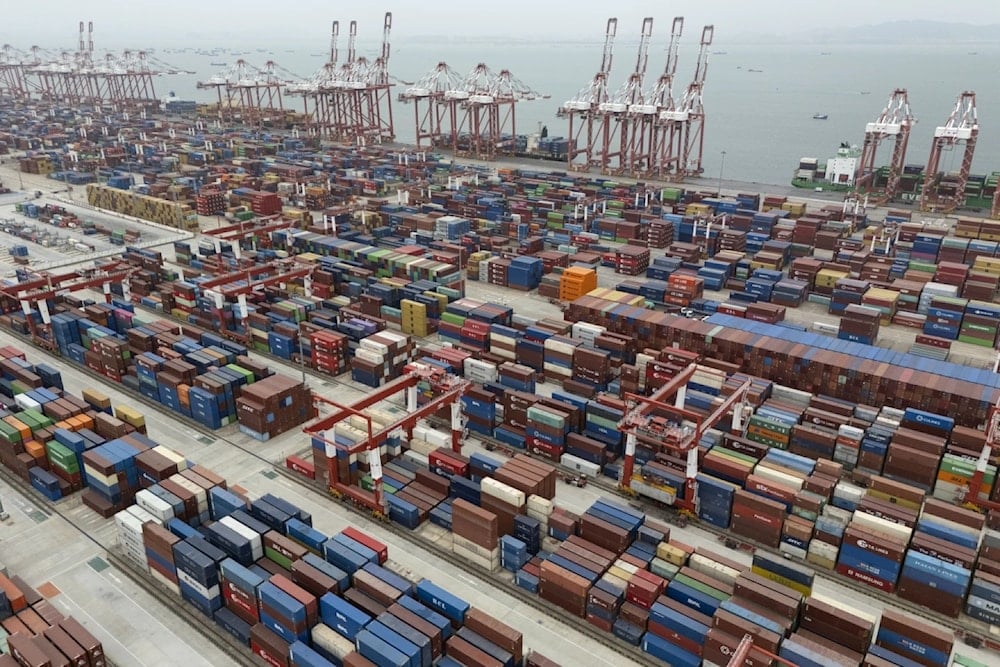US, China strike deal to ease export curbs, avoid tariff spike
Despite agreeing on a framework to revive stalled trade talks and lift rare earth export curbs, major disagreements over Trump’s tariffs remain unresolved.
-

Shipping containers are seen ready for transport at the Guangzhou Port in the Nansha district in southern China's Guangdong province, April 17, 2025. (AP)
US and Chinese officials announced a framework agreement Tuesday to revive their trade truce, with Beijing agreeing to lift restrictions on critical mineral exports. The deal, reached after two days of high-level talks in London, comes amid rising global concern over the consequences of prolonged US-China trade tensions.
US Commerce Secretary Howard Lutnick said the agreement “puts meat on the bones” of a Geneva consensus reached last month, which had begun to falter due to China’s continued curbs on rare earth exports. These export controls prompted retaliatory US measures, including blocking shipments of semiconductor design software, aviation components, and other strategic goods to China.
Speaking after midnight local time, Lutnick said the framework still requires approval from both leaders. “We’re going to go back and speak to President Trump... They’re going to go back and speak to President Xi,” he explained.
China’s Vice Commerce Minister Li Chenggang confirmed that a framework was reached in principle, but emphasized that final endorsement by both governments was necessary before implementation.
Gold rises following US-China trade deal uncertainty
Gold prices rose on Wednesday as uncertainty surrounding the finalisation of a US-China trade agreement weighed on sentiment and fuelled some safe-haven buying, with investors awaiting key US inflation data for further market direction, Reuters reported.
Spot gold gained 0.5% to $3,337.99 an ounce, as of 0544 GMT. US gold futures rose 0.5% to $3,359.20.
"In the short term, the gold price is likely to consolidate before staging another rally toward $3,600/oz by year-end," ANZ Research said in a note.
Meanwhile, spot silver was down 0.1% to $36.52 per ounce, platinum rose 1.4% to $1,238.97, while palladium was up 1% to $1,070.88.
Tariff truce preserved but core disagreements remain
While the agreement may prevent the collapse of the Geneva deal, analysts noted that it does little to resolve enduring disputes over Trump tariffs and longstanding US grievances with China’s state-led economic model.
The Atlantic Council’s Josh Lipsky commented, “They are back to square one, but that’s much better than square zero.” The Geneva deal left both parties with conflicting interpretations of its terms, highlighting the need for clear follow-through.
Without a final agreement by August 10, tariff rates are set to surge, jumping from 30% to 145% on US goods and from 10% to 125% on Chinese exports. Markets reacted cautiously. The MSCI Asia-Pacific index outside Japan rose 0.57%, though investors remained wary. “The devil will be in the details,” said Chris Weston of Pepperstone, referencing the uncertain scope of rare earth and chip trade relaxations.
Rare earth access key to new deal
Lutnick emphasized that rare earth minerals and magnets, a sector in which China holds a near-monopoly, were central to the framework. China’s earlier decision to halt exports of these critical materials had disrupted global supply chains, particularly in electric vehicle and defense manufacturing.
“In response, the United States took its own measures,” Lutnick said. “You should expect those to come off... in a balanced way.”
The US had also revoked export licenses for semiconductor software and aviation components, steps that rattled American manufacturers and drew pushback from multiple global partners.
Global economic fallout looms over fragile progress
As negotiations continued in London, the World Bank downgraded its global growth forecast for 2025, citing a four-tenths percentage point cut to 2.3%. The report linked rising trade barriers, including Trump’s sweeping tariff policies, to mounting risks for the global economy.
Christine Lagarde, president of the European Central Bank, called for coordinated global policy adjustments during a rare visit to Beijing, warning of “mutual economic damage” if financial imbalances persist.
Customs data released Monday showed that China’s exports to the US fell by 34.5% in May, the steepest drop since the onset of the COVID-19 pandemic. Meanwhile, Trump’s shifting tariff policies have disrupted port activity, pushed up consumer prices, and generated uncertainty for corporations and households alike.
Political pressures shape next steps
The framework announcement followed a rare direct phone call between Trump and Xi Jinping, which officials say helped bridge negotiation gaps. Lutnick said the directives from that call were merged with the Geneva consensus to form the London framework.
Today, U.S. Trade Representative Jamieson Greer and @SecScottBessent met with President @keller_sutter and Vice President @ParmelinG of the Swiss Confederation in Geneva.
— United States Trade Representative (@USTradeRep) May 9, 2025
Both sides agreed to accelerate negotiations on reciprocal trade: https://t.co/cGAfh4bVvv pic.twitter.com/szlWivdFJu
Present at the talks were US Trade Representative Jamieson Greer and Treasury Secretary Scott Bessent, who departed early to testify before Congress.
Hours after the deal was announced, a US appeals court upheld Trump’s most sweeping tariffs, allowing them to remain in effect while a legal review is underway. These include the 34% “reciprocal” tariffs that remain a major point of leverage in the ongoing talks.
The Trump administration is under mounting pressure from domestic industries, foreign governments, and international airlines to suspend further tariff actions, particularly on aerospace imports. Despite the current framework, stakeholders warn that unless a comprehensive deal is reached before August, a renewed escalation in the US-China trade war may be unavoidable.

 5 Min Read
5 Min Read










